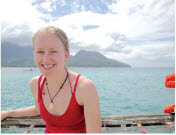
The first thing that struck me about Malaysia was the diversity of people we were surrounded by. It is sometimes easy to forget when living in Korea how truly homogeneous it is here, especially when compared with other nations. While standing in Pudu Sentral station, waiting for a bus to Lumut, a spectrum of ethnicity and culture was immediately on show. Vibrant saris flowed alongside less decorative black burqas, which were outnumbered by colourful hijabs. There were even young couples holding hands and baring their shoulders. Malaysia is considered a successful example of a multicultural society. As of 2010, 60.3% of the population were Malays, 22% Chinese and nearly 9% Indian, with each group conducting their own religions and customs. It was this mix that I bore witness to, and it was exhilarating to see.
As we pulled out of the bus station we had a quick glimpse of Kuala Lumpur and saw that its buildings were as various as its people. Aging, and in some cases decrepit, structures were hidden amongst the ultra modern. There were colonial keepsakes alongside magnificent mosques and, of course, the Petronas Towers. I admired the assortment. As we came in to land earlier that day we had noticed from above miles of plantations and speculated on what they were. Now on the bus we were able to recognise that they were all coconut trees; the straight lines indicated human intervention - an export crop no doubt.
Lumut, a small coastal town four hours north of Kuala Lumpur, was pleasant enough. Our first Malay meal was at an eatery opposite the terminal. It was cheap and crowded and served wonderfully fresh roti with dal. For such a small town I was surprised but delighted to later discover a few expatriate-style pubs which offered high quality, authentic European food. Even Seoul’s establishments would find it difficult to compete. The community here was as multicultural as in the capital, and included groups of western teachers and engineers, adding further to the diversity. However, Lumut was a brief stopover and we were quick to board the forty-five-minute boat to an island just seven kilometres off shore, Pulau Pangkor.
With a population of approximately 30,000, Pangkor is a laid back little island with all the amenities necessary to shake off your study and work woes and truly relax. There is accommodation to suit most people. We were looking for something quiet and down to earth. I would recommend Nazri Nipah Camp to anyone who would like to spend their mornings swaying in a hammock whilst being serenaded by the wind passing though the tropical fauna, and at a cheap price. The manager, Put, offered more evidence towards Malaysia’s mixed society. He was clearly of Indian descent, though had Rastafarian dreadlocks and a wife who was of Malay background.
With only ten days of vacation we were keen to explore the island intimately. Our chosen spot, Teluk Nipah, was perfectly set back from two lovely bays. The sand was not as pristine as its Perhentian counterparts, but it was good enough. The view out across the ocean was interrupted by the tiny uninhabited islands of Pulau Giam and Pulau Mentagor, a couple of kilometres off shore. The sea was calm and the water clear. It was a Saturday when we arrived so the local population filled the cheap-eats lining the beach. We had anticipated the weekend revellers, so without hesitation nestled in among them and dived into some local food. There was a salivating selection of rich curries, fried rice and noodle soups, and in the evening we had the additional choice of freshly caught fish.
There are roughly two hundred mammal species in Malaysia, along with over six hundred species of birds, and Pangkor offered great examples of both. Our wooden hut was visited daily by a rhesus macaque. His behaviour was mischievous and we surmised that he liked to break away from his troop to tease the resident humans. However, it was more usual to witness these monkeys in larger numbers. We saw generations of the same family awkwardly traverse the electrical cables which crisscrossed the island; the occasional one would slip and, according to locals, could be hit and killed by passing vehicles - an example of the modern world encroaching onto the older one.
Equally captivating to watch and just as plentiful as the rhesus macaques were the oriental pied hornbills. With beaks stacked like double-decker buses, these large creatures were quite distinct from any species of bird I had seen elsewhere in the world. They flourish in the tropical forest which covers the centre of Pangkor but are often seen in its populated outer rim. Though their natural diet may be fruits, reptiles and large insects, it was common to see their beaks bashing into piles of rubbish found outside restaurants, providing the monkey’s hadn’t beaten them to it!
As our vacation drew to an end I considered what others think of when they hear the word ‘Malaysia.’ For some it is the famous Perhentian Islands which bless the Eastern coast, for others it is the rich Islamic culture which saturates the society, or perhaps, as with me, it is the catchy slogan: ‘Malaysia, truly Asia,’ which I feel is justified given its Asian diversity. Whatever your thoughts, you should consider that with today’s budget airlines Kuala Lumpur is an affordable destination from Seoul or Busan, and with the summer break a couple of months away, now is the time to book.
- 기자명 GLOBE
- 승인 2014.05.13 10:13
- 댓글 0

